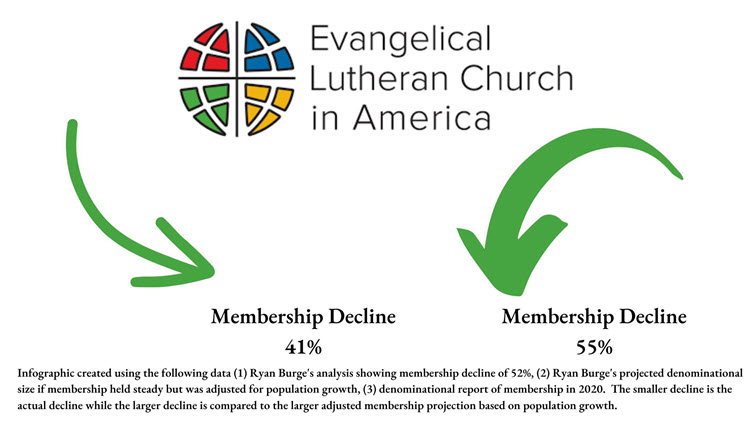I deeply appreciate and have personally been involved in the life of the Mainline Protestant denomination known as the Evangelical Lutheran Church in America. Given my prior involvement in this tradition, I strive to tell the whole story of how the denomination has arrived at its present state so that those involved can use this information as they plan for a brighter future.
Mainline Decline
Much has been written about Mainline decline in general, and about the decline of the Presbyterian Church (USA) specifically. I am one of the writers who continues to contribute to this growing body of literature.
Evangelical Lutheran Church in America Decline
Earlier this week, sociologist Ryan Burge tweeted that the Evangelical Lutheran Church in America (along with its Mainline siblings) is in worse shape than most statistical analyses suggest. Burge’s issue is with the most common methodology for calculating denominational decline over time. The generally accepted method chooses a time period then evaluates the percentage of decline in the denomination’s membership during that time period. Burge, however, suggests a more accurate analysis would require the adjustment of the denomination’s baseline membership number based on population growth. (Previously, I explored how this approach impacts the United Church of Christ: The UCC is Missing 1.3 Million People and the Presbyterian Church (USA) – The PC(USA) is Missing 2.6 Million People!)

In his tweet thread, Burge first showed that from 1987 to 2021 the Evangelical Lutheran Church in America declined 41% according to denominational records. Then, he showed that based on population growth per the U.S. Census Bureau, the denomination’s membership would have risen to 7.0 million if the growth rate had been 0.0%. Instead, the denomination ended this period at 3.0 million which is a decrease of 55.1% or approximately 14% higher than the commonly used number.
So What?
The widely publicized decline of 41% is accurate. The denomination’s total membership has lost 2 of every 5 members over the last 30+ years.
It is also an incomplete analysis. A better comparison over time would be percentage of the American population belonging to the ELCA This is the number from Burge’s analysis – a number that is 16% higher (41% vs 55%). The difference in the two numbers is significant.
In 1990 the ELCA had 5,240,739 members. Adjusted for increased in population and assuming a 0% growth rate, the denomination would have stood at 7.0 million members. The actual number, however, was just 3,142,777 in 2020.
As Burge noted and as other analysis consistently show the decades long decline of Mainline Protestantism has impacted all Mainline denominations. I’ve singled out the ELCA for this post to ensure it receives adequate attention.
Acknowledging this change and understanding its causes is essential to charting a future marked by growth and vitality.
More on ELCA Decline
To better appreciate the decline in the ELCA, check out some of my posts on the topic:
Note: ELCA membership fell to 3,035,635 in 2021.
More on Ryan Burge
To better appreciate Ryan Burge’s work, consider reading some of my posts that mention his scholarship:
- End of Presbyterianism: Farewell (2023)
- The Only Major Denomination That Keeps Growing (2022)
- Top 10 Books of 2022 (includes his book: 20 Myths About Religion and Politics in America.) (2022)
- Mainline Decline: 1990 to 2020 (2022)
- Lifelong Retention: A Religious Challenge (2022)
- Great New Books – May 2021 (includes his book: The Nones: Where They Came From, Who They Are, and Where They Are Going ) (2021)
- Mainline: The 5 Percent? (2019)